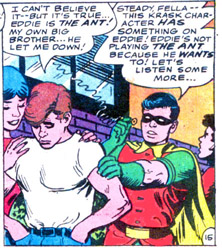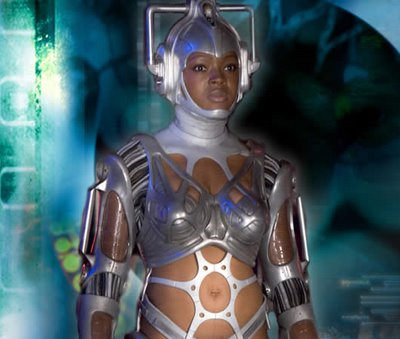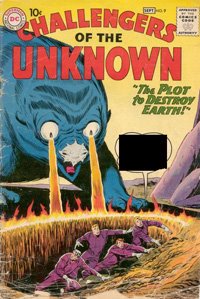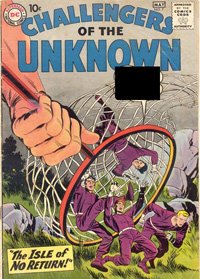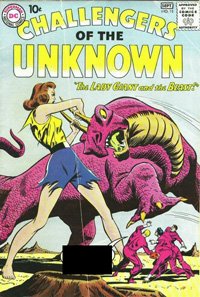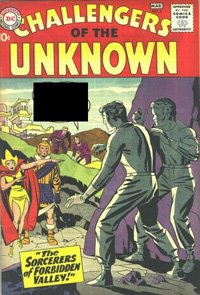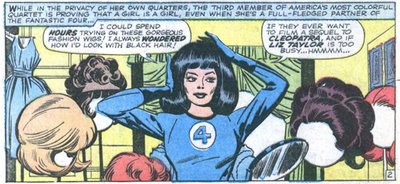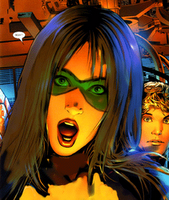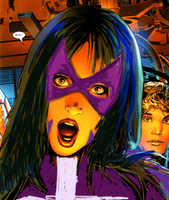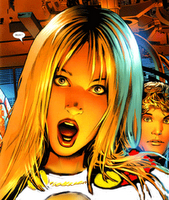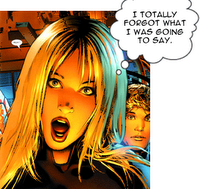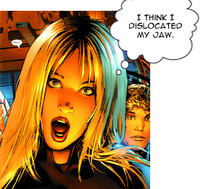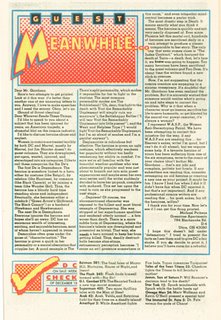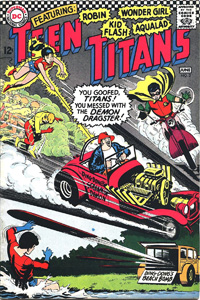 Teen Titans volume 1 #3
Teen Titans volume 1 #3I've been reading the
Teen Titans Showcase collection and one thing has been bugging me all week. How is it that I can cheerfully accept Wonder Woman flying a propellor driven airplane to Mars while fighting pteradactyls in space, or Lois Lane wearing a safe on her head because it's less embarassing than letting anyone see her face, and yet Bob Haney crosses some unseen line of stupid where I find myself rolling my eyes on almost every page?
After a lot of thought I've decided that the difference is that Bob Kanigher's Wonder Woman and a lot of the more peculiar 60's Superman and 50's Batman works because it is fairy tale fantasy; no effort is made to convince you it has any relation to the real world. You can take your brain out and just have fun, knowing that anything is possible. Conversely, Haney is forever attempting to ground his stories in realism and trying to tie it to the everyday world, and then doing something that flaunts his ignorance of his subject matter. That and Teen Titans tries so hard to be trendy that it's not only horribly dated, but it reads like your dad trying to sound cool.
I'd originally planned to just do one article on this collection but that would be a terrible waste of good snark, so I'm going to make it an occasional series. I may get back to earlier issues at some point but right now I'm going to focus on issue #3, as it's the one I just finished.
The story jumps right into the action with a bank in Gotham being robbed by a wacky looking custom car, (1). It's tough being a villain (2) in Gotham. Not only do you get chased by Batman, but the banks are equipped with machine guns.

The police are nowhere to be seen, but the batmobile is soon on the tail the hot rod. It attempts to lose the pursuit by driving into a river where it becomes a hovercraft (3). But the Batmobile continues the chase as a hydrofoil. Unfortunately in Haneyworld hovercraft are faster than hydrofoils. Even this one which has no skirt to trap the air shooting out of its undercarriage and no apparent means of forward propulsion.

The villains (4) get away. Where could they have got that fancy car from, muses Batman, as Robin receives a message that will conincidentally take him to the very place Batman is wondering about.
The Teen Titans are summoned to Washington to do a job for the President's Commission of Education. (5) The PCoE is running a campaign to stop kids dropping out of school (6) and it's just occured to them they don't have any actual teenagers associated with it so they want to bring the Titans in to help, because costumed vigilantes make the best role models.
So do they want the Titans to:
A) go on chat shows encouraging kids to stay in school?
B) investigate the high drop-out rate of some small town nobody has ever heard of?
Obviously it's B because government departments don't have staff to look into stuff like that, and it's not a ludicrous waste of resources.
Arriving in Nowheresville they talk to the school principal (7) who is particularly puzzled about one high achiever who dropped out. It's a shame he's not concerned enough to make the effort to find out that the boy left because he needed to earn money to keep his family after his father died, but it suggests that part of the problem here might be down to the way the school is run.
In fact this student and every other kid who reaches drop-out age has gone to work at Ding-Dong Daddy's Hot-Rod Hive. (8) Rather than hire skilled mechanics, Ding-Dong employs children who haven't finished high school to build custom cars. And it's not some kind of cheap wages scam either, as we are informed that he pays well. The Titans visit Ding-Dong and Kid Flash finds some kids tricking out an ice cream tricycle with a machine gun (9).
The Titans pretend to leave but in fact keep the building under surveilence from their helicopter, somehow assuming that Ding-Dong won't notice it. Three vehicles leave the chop shop at the same time, and Kid Flash, Wonder Girl, and Aqualad each follow one. It's just as well one of them takes the beach road or Aqualad would have been stuffed. Several examples of improbable physics later (10) all three Titans are out for the count, but Robin doesn't know because instead of backing up his chums he takes the opportunity to sneak in to the workshop and find the car he and Batman had chased in Gotham.
A brief scuffle later (11) and Robin is tied to a motorcycle with the brakes cut and the throttle wedged open and sent hurtling away to his doom (12). It's here we find that Robin may be the brains of the team but he knows nothing about motorcycles. If you woke up to find yourself tied to a runaway mororcycle with no brakes would you:
A) Slow the vehicle using the gears for engine braking?
B) switch off the fuel tank?
C) Pull out the spark plug cable?
D) Jump the cycle off a conveniently placed ramp into a conveniently placed mound of sand?
E) Drop the stupid bike and risk a few bruises because it can only have been doing about 20 miles an hour maximum?
So our heroes regroup and a convenient subplot occurs to help them on their way, as Ding-Dong attempting to murder Robin isn't good enough evidence to take to the authorities. It seems that the kids who work at Ding-Dong's have rivals who ride motorcycles and are armed with spanners, and are prone to random acts of violence. Forgetting that they have access to armour-plated hovercraft equipped with machine guns, they quake with fear until the Titans turn up in disguise and beat up the bikers for them. The kids are so happy that they cheerfully recommend the disguised heroes for work at Ding-Dong's.

A rare good point occurs when Ding Dong asks Wonder Girl if she is a mechanic, rather than assuming she is a bubble headed bimbo who intends to dance to music all day to "encourage" the workers like some kind of workshop cheerleader (13). She then takes him into his office and jiggles for him so the boys can get on with the real work while he is distracted.
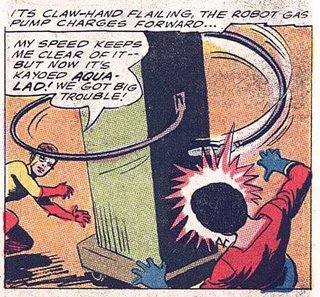
Robin then uses a gizmo to broadcast what is being said in the "secret" room where someone is conveniently explaining the plot. The kids are shocked, shocked, I tell you, to find that all the bullet-proof, machine gun armed hovercraft they are building are intended to be sold to villains. Ding-Dong unleashes a robot gas pump but is quickly defeated by someone other than a Titan. The kids all decide to go back to school (14) and everyone is happy.
Good points:Ding-Dong is visually based on artist Big Daddy Roth, famous for drawing weird vehicles.
It's very rare for the period to get a story that focusses on something like where villains get their fancy gear from.
The surfboard firing van and the robot gas pump.
Ding-Dong is an equal opportunities employer.
Bad points:Everything else.
Notes.
1. because obviously if you are committing armed robbery you'd want a getaway car that was strange enough looking that you could spot it from orbit rather than one that would blend into a traffic jam.
2. or indeed a bank customer.
3. Artist Nick Cardy has no idea what a hovercraft looks like.
4. we never find out who they are.
5. Doesn't this conflict with their membership of the Peace Corps?
6. I know nothing about the american education system, but it seems to me it might be an idea to have the final exam while school is compulsory, rather than after a lot of people have left.
7. the town is so small it only has the one school.
8. Well, the male ones at least. We never see any female teenagers. Or adults. In fact the only female in the whole comic is Wonder Girl.
9. There is an effort made later to explain that the kids are all nice really and hadn't known about the illegal side of the business. The only way I can see this working is if the kids are too dumb to realise that the gun emplacements, robot arms, and bullet-proof armour are in any way unusual components. Though this could explain why Ding-Dong is training kids instead of hiring proper mechanics.
10. the van that fires surfboards is best.
11. Do the Titans ever win a fight without help?
12. rather than immediately stalling the second it was put in gear or falling over sideways.
13. which, sadly, is her actual plan.
14. including the one who only dropped out because his family needed the income to survive.
 Teen Titans v1 #6
Teen Titans v1 #6
 tried to explain it at all. And I'm not sure how old the Titans are supposed to be in this series; I would guess late teens, but as with almost every issue there's at least one panel where they've been replaced by six year olds.
tried to explain it at all. And I'm not sure how old the Titans are supposed to be in this series; I would guess late teens, but as with almost every issue there's at least one panel where they've been replaced by six year olds. But this issue also includes one of the great stupid moments of the silver age. The Titans are in the middle of a big fight with the hypnotised Beast Boy who has turned into some kind of hybrid half-gorilla half-boa constrictor (4) and the real villain of the piece who has no super powers is so caught up in the moment that he ignores his minion's quite sensible suggestion that they run away with the loot and has climbed into the human cannonbal's cannon so he can be shot up into the middle of the fight that is taking place overhead, armed only with a couple of flaming torches (5). What he thinks this will achieve is never made clear.
But this issue also includes one of the great stupid moments of the silver age. The Titans are in the middle of a big fight with the hypnotised Beast Boy who has turned into some kind of hybrid half-gorilla half-boa constrictor (4) and the real villain of the piece who has no super powers is so caught up in the moment that he ignores his minion's quite sensible suggestion that they run away with the loot and has climbed into the human cannonbal's cannon so he can be shot up into the middle of the fight that is taking place overhead, armed only with a couple of flaming torches (5). What he thinks this will achieve is never made clear.

